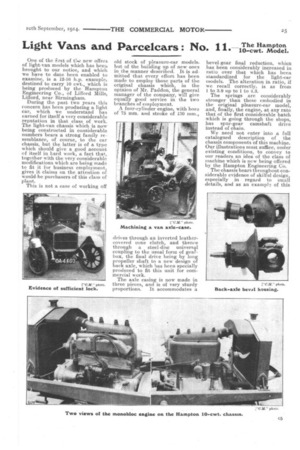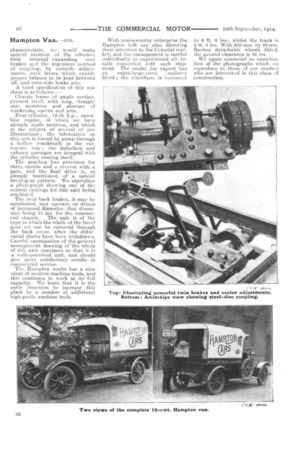Light Vans and Parcelcars : No. 11.
Page 7

Page 8

If you've noticed an error in this article please click here to report it so we can fix it.
The Hampton 10-cwt. Model.
One of the i.Irst of tle,..7.) new offers of light-van models which has been brought to our notice, and which we have to date been enabled to examine, is a 12-16 h.p. example, destined to carry 10 cwt., which is being produced by the Hampton Engineering Co., of Lifford Mills, Lifford, near Birmingham.
During the past two years this concern has been producing a light car, which we understand has earned for itself a very considerable reputation in that class of work. The light-van chassis which is now being constructed in considerable numbers bears a strong family resemblance, of course, to the car chassis, but the latter is of a type which should give a good account of itself in hard work, a fact that, together with the very considerable modifications which are being made to fit it for business employment, gives it claims on the attention of would-be purchasers of this class of plant.
This is not a case of working off old stock of pleasure-car models. but of the building up of new ones in the manner described. It is admitted that every effort has been made to employ those parts of the original chassis which, in the opinion of Mr. Paddon, the general manager of the company, will give equally good service in the two branches of employment.
A four-cylinder engine, with bore of 75 mm. and stroke of 120 mm.,
drives through an inverted leathercovered cone clutch, and thence through a steel-disc universal coupling to the usual form of gearbox, the final drive being by long propeller shaft to a new design of back axle, which has been specially produced to fit this unit for commercial work.
The axle casing is now made in three pieces, and is of very sturdy proportions. It accommodates a
bevel-gear final reduction, whicn has been considerably increased in ratio over that which has been standardized for the light-ear models. The alteration in ratio, if we recall correctly, is as from 1 to 3.9 up to 1 to 4.3.
The springs are considerably stronger than those embodied in the original pleasure-car model, and, finally, the engine, at any rate that of the first considerable batch which is going through the shops, has spur-gear camshaft drive instead of chain.
We need not enter into a full catalogued description of the chassis components of this machine. Our illustrations must suffice, under existing conditions, to convey to our readers an idea of the class of machine which is new being offered by the Hampton Engineering Co. The chassis bears throughout considerable evidence of skilful design, especially in regard to small details, and as an example of this characteristic, we would make special mention of the effective twin internal expanding rear brakes and the ingenious method of coupling, by suitable adjust-. meats, twin levers which enable proper balance to be kept between offand near-side brake sets.
A brief specification of this machine is as follows :-
Chassis frame of ample section, pressed steel, with lung, straight side members and absence of weakening curves and sets. Four-cylinder, 12-16 h.p., monobloc engine, of which we have already made mention, and which is the subject of several of our illustrations ; the lubrication on this unit is forced by pump through a hollow crankshaft in the cus• ternary way ; the induction and exhaust passages are integral with the cylinder casting itself. The gearbox has provision for three speeds and a reverse with a gate, and the final drive is, as already mentioned, of a special bevel-gear pattern, We reproduce a photograph showing one of the central castings for this axle being machined.
The twin back brakes, it may be mentioned, now operate on drums of increased diameter, that dimensiou being 14 ins, for the commer
cial chassis. The axle is of the type in which the whole of the bevel gear set can be removed through the back cover, after the differential shafts have been withdrawn. Careful examination -of the general arrangement drawing of the whole of this axle convinces us that it is a well-conceived unit, and should give quite satisfactory results in commercial service.
The Hampton works has a nice plant of modern machine tools, and this continues to work at its full capacity. We learn that it is the early intention to in-crease this plant by a number of additional high-grade machine tools. With praiseworthy enterprise the Hampton folk are also directing their attention to the Colonial market, and the management is careful individually to superintend all -details connected with such shipment. The model for export has an extra-large-sized radiator fitted ; the wheelbase is increased
to 9 ft. 6 ins., whilst the track is 4 ft. 8 ins. With 910 mm. by 90 rum, Sankey detachable wheels fitted, the giound clearance is 12 ins.
We again commend an examination of the photographs which we reproduce to those of our readers who are interested in this class ef construction,


















